 |
 |
Becky Dirks Haugsted provided the images and Janet A. Brandt transcribed the text
The publisher dedicates this Memorial to the devoted American mothers of the fallen heroes of the World War. To them more than to any other influence is due the heroic spirit of our martyred dead. There is no other nation that has ever placed woman on the high plane of political and social equality now occupied by the American mother. All this has been accomplished without the sacrifice of those qualities of head and heart which have made the word "mother" the sweetest to fall from human lips. The bold agitators could accomplish nothing in any clime, but the gentle spirit of self sacrifice has gained womanhood in the United States recognition fitting the sacrifice made by millions who sent their sons to fight for freedom.
The World War has been described as the greatest human effort of all time. It was more than a contest of armies. It was the death struggle of whole nations, where every man, woman and child had to do a part to save the world from the awful curse of autocracy and the culture of the sword, deified by Mohammed and raised by his modern prototypes in the effort to spread cultures and creeds by flame and steel. To the martyred heroes of America fell the glorious part of putting the final barrier to this modern effort of militarism, the last of sword culture.
The JOURNAL feels that this little Memorial is incomplete. It does not contain all the names of those who have rendered distinguished service and who have shed honor and glory on our country. We have been unable to get portraits of all the dead and wounded from Jones County. We will supplement the later reports of casualties by mention in the columns of the JOURNAL as we have from week to week during the war.
Each the following photos can be clicked on for a larger view. The following may not be in the same order as the original book.
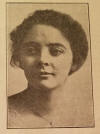 Our first Red Cross Volunteer to give her life for the cause of liberty
and humanity was Miss Pauline Quigley of Anamosa who died at Camp
Custer, Battle Creek, Michigan, October 18, 1918. Miss Quigley was
born in Anamosa and was the youngest child of the late William F.
Quigley and Statia Power Quigley. She enlisted in the Red Cross
field work in July, 1918. When the epidemic of influenza prostrated
thousands of our soldiers in the camps and when many strong men and
women feared ravages of the disease, Miss Quigley went willingly to
the aid of our stricken soldiers. While in the Camp Hospital she was
stricken by the fatal disease. The Chicago Tribune stated that the
untimely death of Miss Quigley and one other nurse the same day,
caused profound sorrow among the soldiers, more than the death of
hundreds of their own ranks. She was regarded as a martyr by the
Camp Custer soldiers. Miss Quigley now rests in quiet Holy Cross
Cemetery at Anamosa and her memory will long be cherished by a
grateful people.
Our first Red Cross Volunteer to give her life for the cause of liberty
and humanity was Miss Pauline Quigley of Anamosa who died at Camp
Custer, Battle Creek, Michigan, October 18, 1918. Miss Quigley was
born in Anamosa and was the youngest child of the late William F.
Quigley and Statia Power Quigley. She enlisted in the Red Cross
field work in July, 1918. When the epidemic of influenza prostrated
thousands of our soldiers in the camps and when many strong men and
women feared ravages of the disease, Miss Quigley went willingly to
the aid of our stricken soldiers. While in the Camp Hospital she was
stricken by the fatal disease. The Chicago Tribune stated that the
untimely death of Miss Quigley and one other nurse the same day,
caused profound sorrow among the soldiers, more than the death of
hundreds of their own ranks. She was regarded as a martyr by the
Camp Custer soldiers. Miss Quigley now rests in quiet Holy Cross
Cemetery at Anamosa and her memory will long be cherished by a
grateful people.
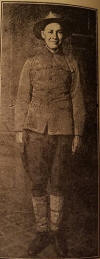 Private
Arthur McCullough of Anamosa was the first Jones County boy to give
his life in action in the World War. He died on May 27, 1918, from
wounds received while serving with the 168th (Iowa) Infantry of the
Rainbow division. He was a member of the Machine Gun Company. He
enlisted on April 9, 1917, and was trained at Ft. Des Moines. His
Regiment landed in England Dec. 9, 1917. Arthur McCullough was born
in Fairview, Jones County, Iowa, Feb 22, 1899. His parents were
Joseph McCullough and Libbie Leaper McCullough. His mother passed
away in January, 1903, and he made his home from that time with his
grandmother, Mrs. John A. Leaper, a soldier's widow in Anamosa.
Three brothers, Jack, Farl and Homer also served in the World War,
making a record for service for one family reflecting credit on the
loyal lineage of the old civil war veteran. Arthur was a boy loved
by all and in whom we feel a just pride for his willing sacrifice of
his young life for his country and for humanity.
Private
Arthur McCullough of Anamosa was the first Jones County boy to give
his life in action in the World War. He died on May 27, 1918, from
wounds received while serving with the 168th (Iowa) Infantry of the
Rainbow division. He was a member of the Machine Gun Company. He
enlisted on April 9, 1917, and was trained at Ft. Des Moines. His
Regiment landed in England Dec. 9, 1917. Arthur McCullough was born
in Fairview, Jones County, Iowa, Feb 22, 1899. His parents were
Joseph McCullough and Libbie Leaper McCullough. His mother passed
away in January, 1903, and he made his home from that time with his
grandmother, Mrs. John A. Leaper, a soldier's widow in Anamosa.
Three brothers, Jack, Farl and Homer also served in the World War,
making a record for service for one family reflecting credit on the
loyal lineage of the old civil war veteran. Arthur was a boy loved
by all and in whom we feel a just pride for his willing sacrifice of
his young life for his country and for humanity.
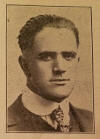 Hubert
Blayney, son of Mr. and Mrs. Gilbert Blayney of Olin was one of the
first to enlist after the declaration of war, he having volunteered
as a member of the Tipton Machine Gun Co. which was a part of the
old First Iowa and went overseas as the 168th Regiment of the
Rainbow Division. He was wounded early in the conflict and was later
fatally injured and died on July 2, 1918. He was the first Olin boy
to give his life in line of action in France. Hubert was a general
favorite in his home town and in the county of his birth, having
spent his entire life in Jones County until he accepted the call of
his country in the World War. The people of Olin held appropriate
memorial services in honor of the departed hero. More imposing
ceremonies will be held when the government has carried out the plan
to bring the body home for burial in his native city. Olin has been
highly honored by the fine body of young men sent to the service
from that vicinity, but none more than by Private Hubert Blayney.
Hubert
Blayney, son of Mr. and Mrs. Gilbert Blayney of Olin was one of the
first to enlist after the declaration of war, he having volunteered
as a member of the Tipton Machine Gun Co. which was a part of the
old First Iowa and went overseas as the 168th Regiment of the
Rainbow Division. He was wounded early in the conflict and was later
fatally injured and died on July 2, 1918. He was the first Olin boy
to give his life in line of action in France. Hubert was a general
favorite in his home town and in the county of his birth, having
spent his entire life in Jones County until he accepted the call of
his country in the World War. The people of Olin held appropriate
memorial services in honor of the departed hero. More imposing
ceremonies will be held when the government has carried out the plan
to bring the body home for burial in his native city. Olin has been
highly honored by the fine body of young men sent to the service
from that vicinity, but none more than by Private Hubert Blayney.
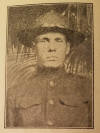 Private
Harold Miner was killed in action on the battlefield in France, Oct.
14, 1918. He was a member of the Machine Gun Co., 168th Infantry,
Rainbow division. He was a son of Mr. and Mrs. Edward Miner of Olin.
Harold was one of the first to offer his services to his loved land,
enlisting at his home town of Olin, April 7, 1917, and left with the
first contingent. Harold Miner was a genial, generous young man and
was a favorite among the young people of his community. When the
official news of his death arrived a short time after his death
there were appropriate memorial services held at Olin Opera House.
He is survived by his parents and their remaining family and by a
large circle of friends who will long cherish the memory of one who
willingly gave his life that we might enjoy the blessings of
universal peace and liberty.
Private
Harold Miner was killed in action on the battlefield in France, Oct.
14, 1918. He was a member of the Machine Gun Co., 168th Infantry,
Rainbow division. He was a son of Mr. and Mrs. Edward Miner of Olin.
Harold was one of the first to offer his services to his loved land,
enlisting at his home town of Olin, April 7, 1917, and left with the
first contingent. Harold Miner was a genial, generous young man and
was a favorite among the young people of his community. When the
official news of his death arrived a short time after his death
there were appropriate memorial services held at Olin Opera House.
He is survived by his parents and their remaining family and by a
large circle of friends who will long cherish the memory of one who
willingly gave his life that we might enjoy the blessings of
universal peace and liberty.
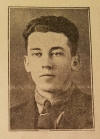 Chauncey
Allen Green was born in Perkins Co., Neb., April 14, 1893. His
father, John A. Green, was a resident of Delaware Co., Ia., but when
war was declared Chauncey was working on a farm in Castle Grove and
registered in Jones County where he had worked for six years. He was
called to Camp Dodge, April 26, 1918, thence to Camp Travis and Camp
Mills. He landed at Southampton, England, went to France in July and
was on duty immediately as a dispatch runner and served bravely
until he was instantly killed on the night of Oct. 26th, 1918, by a
high explosive shell. The scene of his death was the Argonne-Meuse
front near Bantheville. He lies buried near Romanges near the battle
front where he was killed. Private Green was a convert and joined
the Church at Argand, Castle Grove, while employed there and his
body will be returned there for burial.
Chauncey
Allen Green was born in Perkins Co., Neb., April 14, 1893. His
father, John A. Green, was a resident of Delaware Co., Ia., but when
war was declared Chauncey was working on a farm in Castle Grove and
registered in Jones County where he had worked for six years. He was
called to Camp Dodge, April 26, 1918, thence to Camp Travis and Camp
Mills. He landed at Southampton, England, went to France in July and
was on duty immediately as a dispatch runner and served bravely
until he was instantly killed on the night of Oct. 26th, 1918, by a
high explosive shell. The scene of his death was the Argonne-Meuse
front near Bantheville. He lies buried near Romanges near the battle
front where he was killed. Private Green was a convert and joined
the Church at Argand, Castle Grove, while employed there and his
body will be returned there for burial.
 Edward
C. Bakula was one of the first contingent of the Selective Army to
go from Jones County, having been called to Camp Dodge in September,
1917. He proved to be an apt pupil in military training and with
other Jones County boys was sent overseas early in 1918 and assigned
to Co. H. 59th Infantry of the Second Division Regulars. His
division was in fierce battles and in an attack in the St. Mihiel
battle in September, 1918, Private Bakula bravely met death
advancing on the enemy. His Lieutenant, Richard J. Harrigan, sent a
fine tribute to Private Bakula which was published in a local paper,
stating that the dead soldier boy was one of the best all around men
in the company always ready at every call to work or fight when
volunteers were called for on any exceptional assignment. The home
of Private Bakula was formerly at Buena Vista, Clayton County, but
at the time he was called he was working on the farm with his
sister, Mrs. Wencil Marek, north of Anamosa.
Edward
C. Bakula was one of the first contingent of the Selective Army to
go from Jones County, having been called to Camp Dodge in September,
1917. He proved to be an apt pupil in military training and with
other Jones County boys was sent overseas early in 1918 and assigned
to Co. H. 59th Infantry of the Second Division Regulars. His
division was in fierce battles and in an attack in the St. Mihiel
battle in September, 1918, Private Bakula bravely met death
advancing on the enemy. His Lieutenant, Richard J. Harrigan, sent a
fine tribute to Private Bakula which was published in a local paper,
stating that the dead soldier boy was one of the best all around men
in the company always ready at every call to work or fight when
volunteers were called for on any exceptional assignment. The home
of Private Bakula was formerly at Buena Vista, Clayton County, but
at the time he was called he was working on the farm with his
sister, Mrs. Wencil Marek, north of Anamosa.
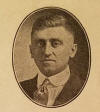 Victor
Shimanek was one of the boys who fell in action in the last battles
which drove the enemy from France. He went with a contingent from
Jones County to Camp Dodge on April 26th, 1918, and from there to
Camp Travis, Texas. After training there he was sent to Camp Merritt
and on June 17th sailed overseas, landing at Liverpool at which
place a great 4th of July Celebration was held by thousands of
Americans. Victor was sent to France and was first in action on
Sept. 12 at St. Mihiel sector. In October he was sent back for a
short rest and again returned to action with his company, D. 358th
Infantry, and in the final drive for Sedan he was killed in action
Nov. 2, 1918. Victor was born Aug. 3rd, 1891, at Oxford Junction,
his parents being Mr. and Mrs. Charles Shimanek. He had the high
privilege of seeing victory for the Stars and Stripes and the glory
of having aided in the final efforts of our noble soldiers.
Victor
Shimanek was one of the boys who fell in action in the last battles
which drove the enemy from France. He went with a contingent from
Jones County to Camp Dodge on April 26th, 1918, and from there to
Camp Travis, Texas. After training there he was sent to Camp Merritt
and on June 17th sailed overseas, landing at Liverpool at which
place a great 4th of July Celebration was held by thousands of
Americans. Victor was sent to France and was first in action on
Sept. 12 at St. Mihiel sector. In October he was sent back for a
short rest and again returned to action with his company, D. 358th
Infantry, and in the final drive for Sedan he was killed in action
Nov. 2, 1918. Victor was born Aug. 3rd, 1891, at Oxford Junction,
his parents being Mr. and Mrs. Charles Shimanek. He had the high
privilege of seeing victory for the Stars and Stripes and the glory
of having aided in the final efforts of our noble soldiers.
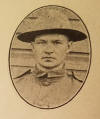 Frank
Dostal of Oxford Junction was killed in action on October 23, 1918.
He was the second of Oxford's young heroes to die in battle. Frank
Dostal was born December 1, 1891, the son of Mr. and Mrs. Jos.
Dostal of Oxford Junction. He went to Camp Dodge on April 25, 1918,
thence to Camp Travis, then to Camp Mills and from that point sailed
for overseas. In September he was in the trenches and with the
exception of a short rest in October his division was in continual
action. Private Dostal was one of the most popular young business
men of Oxford Junction and his death was deeply mourned by the whole
community who while glorifying in his achievement will miss the
familiar face and see the sadness mingled with pride in the features
of the dear old mother who made the supreme sacrifice of her boy.
Frank
Dostal of Oxford Junction was killed in action on October 23, 1918.
He was the second of Oxford's young heroes to die in battle. Frank
Dostal was born December 1, 1891, the son of Mr. and Mrs. Jos.
Dostal of Oxford Junction. He went to Camp Dodge on April 25, 1918,
thence to Camp Travis, then to Camp Mills and from that point sailed
for overseas. In September he was in the trenches and with the
exception of a short rest in October his division was in continual
action. Private Dostal was one of the most popular young business
men of Oxford Junction and his death was deeply mourned by the whole
community who while glorifying in his achievement will miss the
familiar face and see the sadness mingled with pride in the features
of the dear old mother who made the supreme sacrifice of her boy.
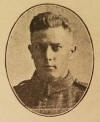 Gilbert
Pavelka, son of Mr. and Mrs. J. P. Pavelka of Oxford Junction, was
killed in action on September 29, 1918. Gilbert was born Feb. 6,
1894, on the farm near Oxford Junction. He was called to Camp Dodge
on Feb. 23, 1918, and later transferred to Camp Seivers, S. C.,
thence to Camp Merritt and later to Halifax, N. S., from where he
sailed overseas in the first part of May, going directly to France.
After a period of training in France he was sent into action. He was
with the American Divisions in the St. Mihiel, where a terrific
drive took place forcing the enemy to hasty retreat, and it was here
that he fell in action. The entire community mourned the death of
this fine young man. He was buried with military honors in the
battle sector where he will rest until means are available to bring
home all the bodies of our fallen dead.
Gilbert
Pavelka, son of Mr. and Mrs. J. P. Pavelka of Oxford Junction, was
killed in action on September 29, 1918. Gilbert was born Feb. 6,
1894, on the farm near Oxford Junction. He was called to Camp Dodge
on Feb. 23, 1918, and later transferred to Camp Seivers, S. C.,
thence to Camp Merritt and later to Halifax, N. S., from where he
sailed overseas in the first part of May, going directly to France.
After a period of training in France he was sent into action. He was
with the American Divisions in the St. Mihiel, where a terrific
drive took place forcing the enemy to hasty retreat, and it was here
that he fell in action. The entire community mourned the death of
this fine young man. He was buried with military honors in the
battle sector where he will rest until means are available to bring
home all the bodies of our fallen dead.
 Private
Wm. E. Cook, a native son of Anamosa was one of the few who lost
their lives at sea while on the way to the battlefields. He was on
the wrecked steamer Otranto which was in collision with the
Kashimere on the Scotch-Irish coast. The sufferings and heroism of
the brave soldiers who battled with the waves in that terrible storm
has been the theme of many writers. The death of one is the history
of the death of all. William was a favorite with all his
acquaintances in Anamosa. He enlisted in the Army in February, 1918,
and was assigned to the position of cook. He seemed to have a
premonition that he might not safely cross the sea. In a letter to
his aunt, Mrs. R. P. Lacy of this city, just before he sailed, he
said he would write if it should happen that he safely landed
overseas. We have not learned the place of burial, but the body will
be returned here
Private
Wm. E. Cook, a native son of Anamosa was one of the few who lost
their lives at sea while on the way to the battlefields. He was on
the wrecked steamer Otranto which was in collision with the
Kashimere on the Scotch-Irish coast. The sufferings and heroism of
the brave soldiers who battled with the waves in that terrible storm
has been the theme of many writers. The death of one is the history
of the death of all. William was a favorite with all his
acquaintances in Anamosa. He enlisted in the Army in February, 1918,
and was assigned to the position of cook. He seemed to have a
premonition that he might not safely cross the sea. In a letter to
his aunt, Mrs. R. P. Lacy of this city, just before he sailed, he
said he would write if it should happen that he safely landed
overseas. We have not learned the place of burial, but the body will
be returned here
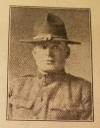 Private
Henry Heiken, son of Mrs. Albert Heiken, Anamosa R. F. D. was killed
in action in France, Oct. 4th, 1918. Henry was in Montana at the
time of the outbreak of the war and went with a contingent from that
state and went overseas early in the conflict. The official casualty
lists credit him to Anamosa and we are justified in claiming him as
he gave his home address as here. Henry was 30 years old and single
His death though attended with the highest honors that man can
attain ”death in battle for humanity" is still felt as a keen loss
by his mother, eight brothers and three sisters all residing in or
near the old home. Henry was an upright, honest citizen, respected
by all and the news of his untimely death was received with sorrow
mingled with pride that he died in a just cause and died a hero's
death. His unfinished work will be taken up by the devoted brothers
and sisters who unitedly will carry it on to a happy conclusion.
Private
Henry Heiken, son of Mrs. Albert Heiken, Anamosa R. F. D. was killed
in action in France, Oct. 4th, 1918. Henry was in Montana at the
time of the outbreak of the war and went with a contingent from that
state and went overseas early in the conflict. The official casualty
lists credit him to Anamosa and we are justified in claiming him as
he gave his home address as here. Henry was 30 years old and single
His death though attended with the highest honors that man can
attain ”death in battle for humanity" is still felt as a keen loss
by his mother, eight brothers and three sisters all residing in or
near the old home. Henry was an upright, honest citizen, respected
by all and the news of his untimely death was received with sorrow
mingled with pride that he died in a just cause and died a hero's
death. His unfinished work will be taken up by the devoted brothers
and sisters who unitedly will carry it on to a happy conclusion.
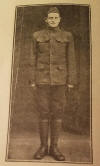 Charles
C. Miller, son of Mrs. O. E. Hall of Monticello, died in France
while he was a member of the regular army. His affliction was
bronchial pneumonia. A letter from his Captain, 34th Service
Company, Signal Corps gives Private Miller a clear record both for
personal character and for efficient service, respected by all his
comrades. Private Miller was born in Arkansas but for a number of
years resided with his mother in Monticello. Charles was too young
for the first registration. He leaves besides his mother, three
brothers, Victor Miller of Onslow, Edward and Bert of Divide,
Wyoming.
Charles
C. Miller, son of Mrs. O. E. Hall of Monticello, died in France
while he was a member of the regular army. His affliction was
bronchial pneumonia. A letter from his Captain, 34th Service
Company, Signal Corps gives Private Miller a clear record both for
personal character and for efficient service, respected by all his
comrades. Private Miller was born in Arkansas but for a number of
years resided with his mother in Monticello. Charles was too young
for the first registration. He leaves besides his mother, three
brothers, Victor Miller of Onslow, Edward and Bert of Divide,
Wyoming.
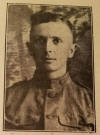 Among
those who went down at sea in the wrecked steamer Otranto in British
waters was David Probasco who formerly lived in Cass and Fairview in
this county. Though unknown to most of the people of this county he
numbered among his friends several in this county who knew him as a
boy on the farm where his father's family lived. The family moved
later to San Jose, Ill. where David grew to manhood. He was there
married but his family was so well provided for that he was allowed
to go to serve his country and met death when his steamer collided
with another vessel in the North Channel. Several hundred men,
mostly from Illinois were lost. Among the number was William Cook of
Anamosa elsewhere mentioned in this book and two or three others
from Iowa. Private Probasco was highly respected by all who knew him
and his fruitless death is yet as honorable as though he had
attained his purpose to strike a blow for liberty and humanity.
Among
those who went down at sea in the wrecked steamer Otranto in British
waters was David Probasco who formerly lived in Cass and Fairview in
this county. Though unknown to most of the people of this county he
numbered among his friends several in this county who knew him as a
boy on the farm where his father's family lived. The family moved
later to San Jose, Ill. where David grew to manhood. He was there
married but his family was so well provided for that he was allowed
to go to serve his country and met death when his steamer collided
with another vessel in the North Channel. Several hundred men,
mostly from Illinois were lost. Among the number was William Cook of
Anamosa elsewhere mentioned in this book and two or three others
from Iowa. Private Probasco was highly respected by all who knew him
and his fruitless death is yet as honorable as though he had
attained his purpose to strike a blow for liberty and humanity.
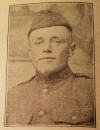 James
Irvin Kairns was one of the Anamosa boys who left on June 25, 1918
for Camp Dodge. He quickly developed efficiency in military training
and was sent overseas. The influenza epidemic was raging when his
contingent left America and soon after landing in France he was
stricken with the malady and died on October 11, 1918. James was the
second son of Mr. and Mrs. Frank Kairns and was born in Anamosa in
1892. A fine tribute to Private Kairns is contained in a letter to
the boy's mother published in a local paper on Jan. 9th from the pen
of Lieut. Wm. Banish of Co. C, 349th Infantry under whom Private
Kairns served. The letter states that the dead solider boy was one
of the most popular and also the most faithful of the company.
Private Kairns was buried at Faubach Le Haut near American lines in
Alsace. He is survived by his parents, one sister and four brothers,
one of whom is in the service.
James
Irvin Kairns was one of the Anamosa boys who left on June 25, 1918
for Camp Dodge. He quickly developed efficiency in military training
and was sent overseas. The influenza epidemic was raging when his
contingent left America and soon after landing in France he was
stricken with the malady and died on October 11, 1918. James was the
second son of Mr. and Mrs. Frank Kairns and was born in Anamosa in
1892. A fine tribute to Private Kairns is contained in a letter to
the boy's mother published in a local paper on Jan. 9th from the pen
of Lieut. Wm. Banish of Co. C, 349th Infantry under whom Private
Kairns served. The letter states that the dead solider boy was one
of the most popular and also the most faithful of the company.
Private Kairns was buried at Faubach Le Haut near American lines in
Alsace. He is survived by his parents, one sister and four brothers,
one of whom is in the service.
 Private
Albert A. Howe of Viola, though from Linn County was during all his
life well known and esteemed in Anamosa and Stone City. He was the
youngest son of William Howe and Bridget Howe and was born Dec. 28,
1893. He grew to manhood on the farm near Stone City. Private Howe
left with the contingent for Camp Gordon in July, 1918, and sailed
overseas in September. He contracted influenza on the voyage and was
taken to the Hospital in England where he died in October. He is
survived by his parents, also five brothers and five sisters. A
letter from the Chaplain who attended him during his last sickness
was received by his mother and states that every comfort of religion
and all human agencies were at hand to aid the departing life.
Private Howe was a strong, robust young man and only the virulence
of a fatal malady could have so quickly overcome the strong
physique.
Private
Albert A. Howe of Viola, though from Linn County was during all his
life well known and esteemed in Anamosa and Stone City. He was the
youngest son of William Howe and Bridget Howe and was born Dec. 28,
1893. He grew to manhood on the farm near Stone City. Private Howe
left with the contingent for Camp Gordon in July, 1918, and sailed
overseas in September. He contracted influenza on the voyage and was
taken to the Hospital in England where he died in October. He is
survived by his parents, also five brothers and five sisters. A
letter from the Chaplain who attended him during his last sickness
was received by his mother and states that every comfort of religion
and all human agencies were at hand to aid the departing life.
Private Howe was a strong, robust young man and only the virulence
of a fatal malady could have so quickly overcome the strong
physique.
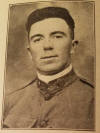 On
October 31, 1918, a telegram from Adjutant General Harris announced
the death of Raymond Louis Keating, overseas. The official notice
gave the date of his death as October 6th. He was the youngest son
of Mrs. Fannie Keating and was twenty-three years old at the time of
his death. His entire life was spent in the schools and the farm
until called to Camp Dodge last summer. In July he was sent to Camp
Merritt and later went overseas. He is survived by his mother, his
sisters Mesdames Thomas McNally, Thomas Flanigan, Thomas Fagan and
John English and his brothers James, William and Bernard all well
known Jones County citizens who will faithfully exemplify in their
devotion to the ideals of the departed brother, his unfinished work.
Private Keating was a young man of much promise, one of the sturdy
young men of whom much was to be expected as a man and a citizen. He
is mourned by a host of friends in his home community who will ever
be edified by his exemplary life so untimely ended.
On
October 31, 1918, a telegram from Adjutant General Harris announced
the death of Raymond Louis Keating, overseas. The official notice
gave the date of his death as October 6th. He was the youngest son
of Mrs. Fannie Keating and was twenty-three years old at the time of
his death. His entire life was spent in the schools and the farm
until called to Camp Dodge last summer. In July he was sent to Camp
Merritt and later went overseas. He is survived by his mother, his
sisters Mesdames Thomas McNally, Thomas Flanigan, Thomas Fagan and
John English and his brothers James, William and Bernard all well
known Jones County citizens who will faithfully exemplify in their
devotion to the ideals of the departed brother, his unfinished work.
Private Keating was a young man of much promise, one of the sturdy
young men of whom much was to be expected as a man and a citizen. He
is mourned by a host of friends in his home community who will ever
be edified by his exemplary life so untimely ended.
 Private
Fred William Folkers, a soldier in the service of his country, died
overseas on Sept. 30, 1918, of pneumonia. A dispatch in October to
his parents in Cass township announced his death. Private Folkers
was born in Cass township, Jones County, Iowa, June 7, 1887. His
parents were Mr. and Mrs. John H. Folkers of Cass. He made his home
on a farm near Anamosa for the past twenty years. He went to Camp
Gordon on July 25, 1918, with a contingent of 189 men from Jones
County and sailed for France some time in September. He was the
youngest of a family of nine children, five of whom with the aged
parents survive. Private Folkers was an industrious young man, a
good citizen and a useful member of society. Besides his immediate
family he is mourned by a large circle of relatives and friends. The
surviving brothers and sisters are Henry of Castle Grove; John,
George and Thomas and Mrs. J. A. Lubben of Cass township.
Private
Fred William Folkers, a soldier in the service of his country, died
overseas on Sept. 30, 1918, of pneumonia. A dispatch in October to
his parents in Cass township announced his death. Private Folkers
was born in Cass township, Jones County, Iowa, June 7, 1887. His
parents were Mr. and Mrs. John H. Folkers of Cass. He made his home
on a farm near Anamosa for the past twenty years. He went to Camp
Gordon on July 25, 1918, with a contingent of 189 men from Jones
County and sailed for France some time in September. He was the
youngest of a family of nine children, five of whom with the aged
parents survive. Private Folkers was an industrious young man, a
good citizen and a useful member of society. Besides his immediate
family he is mourned by a large circle of relatives and friends. The
surviving brothers and sisters are Henry of Castle Grove; John,
George and Thomas and Mrs. J. A. Lubben of Cass township.
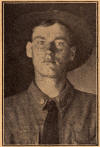 George
Henak, son of Mr. and Mrs. Joseph Henak was born May 30, 1893 near
Oxford Junction. On July 25, 1918, he left his town with the
contingent of 19 boys for Camp Gordon, Ga. He sailed overseas,
embarking on Sept. 12, 1918. He was taken sick with pneumonia
following influenza and died somewhere in France on Sept. 29, 1918.
Private Henak was the first Oxford Junction boy in the overseas
casualty lists, though Gilbert Pavelka was killed in action the same
day. Memorial services for Pri. Henak were held in the Lutheran
Church at Oxford Junction after news of his death reached there The
services were under the direction of the Masonic Lodge of which he
was a member.
George
Henak, son of Mr. and Mrs. Joseph Henak was born May 30, 1893 near
Oxford Junction. On July 25, 1918, he left his town with the
contingent of 19 boys for Camp Gordon, Ga. He sailed overseas,
embarking on Sept. 12, 1918. He was taken sick with pneumonia
following influenza and died somewhere in France on Sept. 29, 1918.
Private Henak was the first Oxford Junction boy in the overseas
casualty lists, though Gilbert Pavelka was killed in action the same
day. Memorial services for Pri. Henak were held in the Lutheran
Church at Oxford Junction after news of his death reached there The
services were under the direction of the Masonic Lodge of which he
was a member.
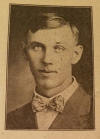 Private
George F. Freese of Co. 21 S. r. D. was born near Amber, Iowa, on
April 22, 1894. He was the son of Mr. and Mrs. Tobe Freese. He went
to Camp Gordon with the large contingent of 189 Jones County men in
July, 1918. He sailed from an American port for overseas in
September and landed in England. The influenza epidemic was then
raging throughout the war ridden countries and he was a victim.
Private Freese died of pneumonia at the military hospital at Hursley
Park about four miles from Winchester, England, and was buried
there. He is survived by his parents and a large family of brothers
and sisters and was a popular young man in this community.
Private
George F. Freese of Co. 21 S. r. D. was born near Amber, Iowa, on
April 22, 1894. He was the son of Mr. and Mrs. Tobe Freese. He went
to Camp Gordon with the large contingent of 189 Jones County men in
July, 1918. He sailed from an American port for overseas in
September and landed in England. The influenza epidemic was then
raging throughout the war ridden countries and he was a victim.
Private Freese died of pneumonia at the military hospital at Hursley
Park about four miles from Winchester, England, and was buried
there. He is survived by his parents and a large family of brothers
and sisters and was a popular young man in this community.
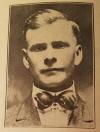 Private
Ben Lorenzen of Olin was the son of S. M. and Brodine Lorenzen. He
was born in Madison twp., Jones County, April 5, 1895. Nearly all
his life was spent on a farm in Hale twp from which place he was
called for the Selective Army. He went to Camp Gordon on July 25th,
1918, and on Sept. 14 sailed with the American Army for England. A
letter from him dated Oct. 5th stated he was in a hospital suffering
with a bad cold, but it proved to be the fatal malady. He passed
away in the hospital at Paington, England, Oct. 20, 1918, from
Spinal Meningitis following Influenza. He was cared for to the last
by a skilled American physician and Red Cross nurses. He was buried
in a beautiful cemetery overlooking the English Channel, with
military honors. He leaves his mother, three sisters and two
brothers.
Private
Ben Lorenzen of Olin was the son of S. M. and Brodine Lorenzen. He
was born in Madison twp., Jones County, April 5, 1895. Nearly all
his life was spent on a farm in Hale twp from which place he was
called for the Selective Army. He went to Camp Gordon on July 25th,
1918, and on Sept. 14 sailed with the American Army for England. A
letter from him dated Oct. 5th stated he was in a hospital suffering
with a bad cold, but it proved to be the fatal malady. He passed
away in the hospital at Paington, England, Oct. 20, 1918, from
Spinal Meningitis following Influenza. He was cared for to the last
by a skilled American physician and Red Cross nurses. He was buried
in a beautiful cemetery overlooking the English Channel, with
military honors. He leaves his mother, three sisters and two
brothers.
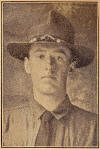 John
J. Rathje was born at Charlotte, Iowa, December 15, 1895. He was a
son of Jurgen Rathje of Wyoming, Iowa. He went into training at Camp
Forest, Georgia, where he was stricken with influenza on Oct. 10,
1918. After a long illness with a period of improvement which gave
hope of recovery, he had a relapse and passed away on October 28,
1918. The remains were brought to Wyoming and buried in the Wyoming
Cemetery. He left surviving his father, one brother and two sisters.
A letter from his Lieutenant to the father spoke in high terms of
the service of Private Rathje, and expressed sympathy for the
bereaved relatives. At the burial service, the G. A. R. gave the
Army burial service and covered the casket with the American flag
for which the young soldier had given his life.
John
J. Rathje was born at Charlotte, Iowa, December 15, 1895. He was a
son of Jurgen Rathje of Wyoming, Iowa. He went into training at Camp
Forest, Georgia, where he was stricken with influenza on Oct. 10,
1918. After a long illness with a period of improvement which gave
hope of recovery, he had a relapse and passed away on October 28,
1918. The remains were brought to Wyoming and buried in the Wyoming
Cemetery. He left surviving his father, one brother and two sisters.
A letter from his Lieutenant to the father spoke in high terms of
the service of Private Rathje, and expressed sympathy for the
bereaved relatives. At the burial service, the G. A. R. gave the
Army burial service and covered the casket with the American flag
for which the young soldier had given his life.
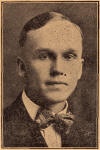 Private
William Worster Walters was one of the five Jones County boys to
pass away at Camp Dodge during one week, his death occurring on
Saturday, Oct. 12. He was the second of three sons of Mr. and Mrs.
Jos. J. Walters of Cass Township. His father and uncle, Mr. Worster
were with the boy at Camp Dodge during his illness. They highly
praised the officials at the Camp Hospital for the solicitude shown
the sick soldier boys and they expressed admiration for the brave
women nurses who worked until exhausted to save the lives of our
boys, many nurses working twelve and fifteen hours per day and never
losing their cheerfulness. The terrible plague overtaxed the
hospital force but they never faltered. William was one of the best
young men of Jones County and was a favorite with all. The funeral
was held from the family home in Cass and burial was in Riverside
Cemetery in Anamosa.
Private
William Worster Walters was one of the five Jones County boys to
pass away at Camp Dodge during one week, his death occurring on
Saturday, Oct. 12. He was the second of three sons of Mr. and Mrs.
Jos. J. Walters of Cass Township. His father and uncle, Mr. Worster
were with the boy at Camp Dodge during his illness. They highly
praised the officials at the Camp Hospital for the solicitude shown
the sick soldier boys and they expressed admiration for the brave
women nurses who worked until exhausted to save the lives of our
boys, many nurses working twelve and fifteen hours per day and never
losing their cheerfulness. The terrible plague overtaxed the
hospital force but they never faltered. William was one of the best
young men of Jones County and was a favorite with all. The funeral
was held from the family home in Cass and burial was in Riverside
Cemetery in Anamosa.
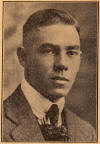 Private
Edward Brady, son of Mr. and Mrs. John Brady of Anamosa, died at
Camp Dodge on Thursday, Oct. 17, 1918, of influenza and pneumonia.
He was the third Anamosa boy and the sixth from Jones County of the
last contingent to succumb to the dread pestilence. His strong
constitution aided him in the battle for life and it was the hope of
those who watched the daily bulletins that his life might be spared.
His mother watched by his bedside in the Camp Hospital through the
long struggle as the thread of life hung tenaciously, lending daily
hope. No human strength could survive the ravages of such virulent
nature. Everything that human skill could do was done, a comfort and
consolation to his family. Like all others of the last contingent he
was 21 years old. Surviving are his parents, four brothers and two
sisters and a large circle of relatives in this community. Burial
was in Holy Cross Cemetery at Anamosa.
Private
Edward Brady, son of Mr. and Mrs. John Brady of Anamosa, died at
Camp Dodge on Thursday, Oct. 17, 1918, of influenza and pneumonia.
He was the third Anamosa boy and the sixth from Jones County of the
last contingent to succumb to the dread pestilence. His strong
constitution aided him in the battle for life and it was the hope of
those who watched the daily bulletins that his life might be spared.
His mother watched by his bedside in the Camp Hospital through the
long struggle as the thread of life hung tenaciously, lending daily
hope. No human strength could survive the ravages of such virulent
nature. Everything that human skill could do was done, a comfort and
consolation to his family. Like all others of the last contingent he
was 21 years old. Surviving are his parents, four brothers and two
sisters and a large circle of relatives in this community. Burial
was in Holy Cross Cemetery at Anamosa.
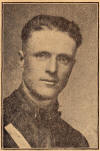 Private
Edward James Zimmerman, aged 21, son of Mr. and Mrs. Wm. G.
Zimmerman, of Anamosa died of influenza and pneumonia at Camp Dodge
on Monday, Oct. 14, 1918. He was one of the contingent of 66 men
composed mostly of boys just 21 who went to Camp Dodge on Sept. 5.
Edward was a kind, manly young fellow who was liked by all. The
remains were brought for burial and funeral services were conducted
at the family home and burial was in Prairie Hill Cemetery in Castle
Grove Township. The death of so many of the young men who went forth
with unbounded enthusiasm in the last contingent, many of them
within one month of the date of departure was a sad realization of
the frailty of even the strongest in physique. The deaths in camp
were not greater in proportion than among the civilian population,
but the anxiety of relatives was greater on account of the boys
being away from home.
Private
Edward James Zimmerman, aged 21, son of Mr. and Mrs. Wm. G.
Zimmerman, of Anamosa died of influenza and pneumonia at Camp Dodge
on Monday, Oct. 14, 1918. He was one of the contingent of 66 men
composed mostly of boys just 21 who went to Camp Dodge on Sept. 5.
Edward was a kind, manly young fellow who was liked by all. The
remains were brought for burial and funeral services were conducted
at the family home and burial was in Prairie Hill Cemetery in Castle
Grove Township. The death of so many of the young men who went forth
with unbounded enthusiasm in the last contingent, many of them
within one month of the date of departure was a sad realization of
the frailty of even the strongest in physique. The deaths in camp
were not greater in proportion than among the civilian population,
but the anxiety of relatives was greater on account of the boys
being away from home.
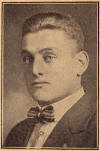 Private
Leo P. Koster, son of Mr. and Mrs. J. P. Koster of Cascade, Jones
County, Iowa, went into service with the Selective Army on Sept. 15,
1918. Leo was born at Cascade, Iowa, on May 2, 1897, and was just
past 21 years of age when he was called to service. He went with the
other Jones County boys to Camp Dodge and became a member of Co. 50,
163rd Depot Brigade. At that time the influenza was sweeping the
whole world and soon appeared at Camp Dodge. Leo was a victim of the
epidemic and gave his young life on October 10, 1918, at Camp Dodge
Hospital from the effects of Influenza and Pneumonia. Burial was at
his former home in Cascade, Iowa.
Private
Leo P. Koster, son of Mr. and Mrs. J. P. Koster of Cascade, Jones
County, Iowa, went into service with the Selective Army on Sept. 15,
1918. Leo was born at Cascade, Iowa, on May 2, 1897, and was just
past 21 years of age when he was called to service. He went with the
other Jones County boys to Camp Dodge and became a member of Co. 50,
163rd Depot Brigade. At that time the influenza was sweeping the
whole world and soon appeared at Camp Dodge. Leo was a victim of the
epidemic and gave his young life on October 10, 1918, at Camp Dodge
Hospital from the effects of Influenza and Pneumonia. Burial was at
his former home in Cascade, Iowa.
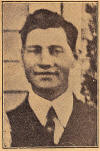 To
many young men of our county was given the inestimable privilege of
going through the fiercest battles and coming home unscathed. To
others it was not vouchsafed beyond a brief service, owing to the
scourge of Influenza which struck down equally solider and civilian.
Joseph Davis of Washington Township went to Camp, wishing as does
every soldier that his life and health might be spared to do his bit
for his country. He was called to Jefferson Barracks, Mo., for
training on Oct. 4, 1918, and within a week was stricken with the
fatal disease and passed away. He was a son of Mr. and Mrs. John
Davis of Washington township. Joseph was thirty one years of age at
the time of his death. The remains were brought to Cascade and laid
to rest in the little cemetery in that city. His memory will long be
cherished. He was a gentle, lovable young man whom fate had not
predestined to war but to the eternal peace beyond.
To
many young men of our county was given the inestimable privilege of
going through the fiercest battles and coming home unscathed. To
others it was not vouchsafed beyond a brief service, owing to the
scourge of Influenza which struck down equally solider and civilian.
Joseph Davis of Washington Township went to Camp, wishing as does
every soldier that his life and health might be spared to do his bit
for his country. He was called to Jefferson Barracks, Mo., for
training on Oct. 4, 1918, and within a week was stricken with the
fatal disease and passed away. He was a son of Mr. and Mrs. John
Davis of Washington township. Joseph was thirty one years of age at
the time of his death. The remains were brought to Cascade and laid
to rest in the little cemetery in that city. His memory will long be
cherished. He was a gentle, lovable young man whom fate had not
predestined to war but to the eternal peace beyond.
 Joseph
Dillon Townsend of Center Junction was one of the first of the Jones
County boys to give his life by disease in Camp. He offered his
services to his country early in the preparations for the coming
struggle. He was a son of Mr. and Mrs. Andrew Townsend, his father
having preceded him in death. He is survived by his devoted mother
who while feeling keenly the loss of the manly boy, taken before he
had a chance to strike a blow for freedom, yet she feels that he did
all willingly. He gave his life and it has been said that no higher
sacrifice can be made by any man than to give his life for others.
Mr. Townsend was highly respected in the community where his whole
life was spent and the news of his untimely death was a shock to the
people of this county.
Joseph
Dillon Townsend of Center Junction was one of the first of the Jones
County boys to give his life by disease in Camp. He offered his
services to his country early in the preparations for the coming
struggle. He was a son of Mr. and Mrs. Andrew Townsend, his father
having preceded him in death. He is survived by his devoted mother
who while feeling keenly the loss of the manly boy, taken before he
had a chance to strike a blow for freedom, yet she feels that he did
all willingly. He gave his life and it has been said that no higher
sacrifice can be made by any man than to give his life for others.
Mr. Townsend was highly respected in the community where his whole
life was spent and the news of his untimely death was a shock to the
people of this county.
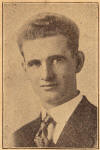 The
first soldier boy of the World War to be buried in Jones County was
Private James Neilly. Word was received here on Jan. 29, 1918, that
Private Neilly had died in a training camp hospital in Texas. He was
the youngest son of Thomas Neilly, an old veteran of the Civil War
who resides in Buffalo township, Linn County, Iowa. James was a
member of the National Army from the state of Washington where he
had been residing for several years. The body was brought to Anamosa
for burial and was attended by a local lodge, the Knights of
Columbus of which order Private Neilly was a member, joining in the
west Burial was in the Cemetery in Anamosa Private Neilly was a
single man. The surviving relatives are his father and a number of
brothers and sister
The
first soldier boy of the World War to be buried in Jones County was
Private James Neilly. Word was received here on Jan. 29, 1918, that
Private Neilly had died in a training camp hospital in Texas. He was
the youngest son of Thomas Neilly, an old veteran of the Civil War
who resides in Buffalo township, Linn County, Iowa. James was a
member of the National Army from the state of Washington where he
had been residing for several years. The body was brought to Anamosa
for burial and was attended by a local lodge, the Knights of
Columbus of which order Private Neilly was a member, joining in the
west Burial was in the Cemetery in Anamosa Private Neilly was a
single man. The surviving relatives are his father and a number of
brothers and sister
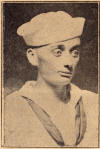 Albert
Francis Moran of Onslow enlisted in the U. S. Navy on May 15, 1918,
at the age of 22 years and ten months. His death was caused by
injuries suffered when a steam launch blew up from internal
explosion on Oct. 3, severely scalding him. Albert was a son of Mr.
and Mrs. William Moran of Clay township, Jones County, Iowa. The
remains were brought back to the old home and burial was in the
Cemetery at Temple Hill. Albert will be missed from the community
where his entire life up to the date of enlistment had been spent.
He was popular among all classes and was admired for his honorable,
manly character.
Albert
Francis Moran of Onslow enlisted in the U. S. Navy on May 15, 1918,
at the age of 22 years and ten months. His death was caused by
injuries suffered when a steam launch blew up from internal
explosion on Oct. 3, severely scalding him. Albert was a son of Mr.
and Mrs. William Moran of Clay township, Jones County, Iowa. The
remains were brought back to the old home and burial was in the
Cemetery at Temple Hill. Albert will be missed from the community
where his entire life up to the date of enlistment had been spent.
He was popular among all classes and was admired for his honorable,
manly character.
(Note: Mr. Moran is named "Alfred" in
the headline and "Albert" in the body. He is listd as "Albert" in
the 1900 U.S. Census.)
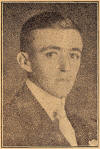 Private
August Gerdes of Monticello, a soldier in the service of his country
died at Camp Forest, Ga., Monday, Oct. 21 of pneumonia. He was taken
sick on Oct. 15 and removed to the hospital on the 17th which time
his wife was notified of his illness. Four days later he passed
away. The body was brought to Monticello and funeral services were
conducted at the home of his mother, Mr. Anna Gerdes. Private Gerdes'
parents were John and Anna. His father died when August was 10 years
old. He remained on the farm with his mother several years and then
removed with her to Monticello. On Dec. 6, 1917, he was married to
Alvina Schlemmer, with whom he made his home on the farm until he
was called to Camp Forest on July 29, 1918. He is survived by his
wife, mother, four brothers and three sisters.
Private
August Gerdes of Monticello, a soldier in the service of his country
died at Camp Forest, Ga., Monday, Oct. 21 of pneumonia. He was taken
sick on Oct. 15 and removed to the hospital on the 17th which time
his wife was notified of his illness. Four days later he passed
away. The body was brought to Monticello and funeral services were
conducted at the home of his mother, Mr. Anna Gerdes. Private Gerdes'
parents were John and Anna. His father died when August was 10 years
old. He remained on the farm with his mother several years and then
removed with her to Monticello. On Dec. 6, 1917, he was married to
Alvina Schlemmer, with whom he made his home on the farm until he
was called to Camp Forest on July 29, 1918. He is survived by his
wife, mother, four brothers and three sisters.
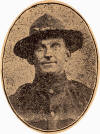 Herman
Miller of Oxford Junction was one of the victims of the influenza
epidemic at Camp Custer, Mich. Where for years a great health resort
was maintained the plague which swept the entire world, struck down
thousands of strong young men. Red Cross nurses, and other
volunteers freely gave their lives to aid the stricken soldiers.
Private Miller was a son of Mr. and Mrs. J. F. Miller and was born
on June 17th, 1891, on the farm southeast of Oxford Junction. He was
employed at Lyons, Neb., from which place he entered the service on
June 24, 1917. He spent two months at Ft. Riley, Kan., and was then
assigned to a medical corps and on Aug. 11 was transferred to Camp
Custer, Mich. Though he did not die in battle, he volunteered his
services and was in the midst of dead and dying in the terrible
plague more tragic in its effects than all the sacrifices of battle.
Herman
Miller of Oxford Junction was one of the victims of the influenza
epidemic at Camp Custer, Mich. Where for years a great health resort
was maintained the plague which swept the entire world, struck down
thousands of strong young men. Red Cross nurses, and other
volunteers freely gave their lives to aid the stricken soldiers.
Private Miller was a son of Mr. and Mrs. J. F. Miller and was born
on June 17th, 1891, on the farm southeast of Oxford Junction. He was
employed at Lyons, Neb., from which place he entered the service on
June 24, 1917. He spent two months at Ft. Riley, Kan., and was then
assigned to a medical corps and on Aug. 11 was transferred to Camp
Custer, Mich. Though he did not die in battle, he volunteered his
services and was in the midst of dead and dying in the terrible
plague more tragic in its effects than all the sacrifices of battle.
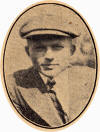 Louis
Sazma was born at Aten, Nebraska, August 25, 1896, and died at Camp
Dodge, Oct. 10, 1918. He was called in the September contingent, the
last to be called in the World War. Though never destined to fight,
the casualties among the boys who became 21 after the first
registration were the heaviest of any units called from Iowa. The
epidemic of influenza was then nearly as fatal to civilians as to
soldiers, but in Camps the great collection of men of the
susceptible age made the appearance of an historical plague. Louis
lived several years on farms near Prairieburg and Oxford Junction.
He was the eldest son of Mr. and Mrs. Mathias Sazma and the mainstay
in the farm work. He was buried in Mayflower Cemetery at Oxford
Junction.
Louis
Sazma was born at Aten, Nebraska, August 25, 1896, and died at Camp
Dodge, Oct. 10, 1918. He was called in the September contingent, the
last to be called in the World War. Though never destined to fight,
the casualties among the boys who became 21 after the first
registration were the heaviest of any units called from Iowa. The
epidemic of influenza was then nearly as fatal to civilians as to
soldiers, but in Camps the great collection of men of the
susceptible age made the appearance of an historical plague. Louis
lived several years on farms near Prairieburg and Oxford Junction.
He was the eldest son of Mr. and Mrs. Mathias Sazma and the mainstay
in the farm work. He was buried in Mayflower Cemetery at Oxford
Junction.
 Henry Benhart, son of Mr. and Mrs. Joe Benhart, Sr., was born at the farm
south-west of Oxford Junction, on Dec. 13, 1896, and died at Camp
Dodge, Tuesday, Oct. 10, 1918, at the age of 21 years. He was one of
the last contingent of boys sent from this county, having become of
military age after the first registration. Never was a contingent
seen to exhibit such tremendous enthusiasm as the one in which
Private Benhart left. They were just rounding to perfect manhood and
full of life and strength. Within a few short weeks a half dozen of
the strongest of our boys were stricken with the influenza, the
strongest appearing to be the easiest victims. The remains were
brought to Oxford Junction where services were conducted by the
Masonic Lodge of which order Private Benhart was a member. The
entire community was shocked at the untimely death of this sturdy
young soldier.
Henry Benhart, son of Mr. and Mrs. Joe Benhart, Sr., was born at the farm
south-west of Oxford Junction, on Dec. 13, 1896, and died at Camp
Dodge, Tuesday, Oct. 10, 1918, at the age of 21 years. He was one of
the last contingent of boys sent from this county, having become of
military age after the first registration. Never was a contingent
seen to exhibit such tremendous enthusiasm as the one in which
Private Benhart left. They were just rounding to perfect manhood and
full of life and strength. Within a few short weeks a half dozen of
the strongest of our boys were stricken with the influenza, the
strongest appearing to be the easiest victims. The remains were
brought to Oxford Junction where services were conducted by the
Masonic Lodge of which order Private Benhart was a member. The
entire community was shocked at the untimely death of this sturdy
young soldier.
 Robert H. Aldrich was born in Wyoming, Iowa, April 20, 1890, and
died in Cedar Rapids, Iowa, Feb. 19, 1919. He was chosen for the
Selective Army in July, 1918, and sailed for overseas with the
Expeditionary Forces in September. He received his honorable
discharge at Camp Dodge on February 18th. Robert was an orphan and
had been a favorite in his home town and they were prepared to
welcome him home, but the secret cause of his seeking death by his
own hand when within a few miles of home is buried with him. There
are only few cases parallel to his, and in those cases of nurses who
drowned themselves on the way home it was supposed to be a re-action
after the strenuous excitement of the war and the subsequent removal
of incentive to heroic effort. Robert is survived by two brothers,
John H. of Spokane, Washington and James F. of Denver, Colorado, who
were present at the funeral.
Robert H. Aldrich was born in Wyoming, Iowa, April 20, 1890, and
died in Cedar Rapids, Iowa, Feb. 19, 1919. He was chosen for the
Selective Army in July, 1918, and sailed for overseas with the
Expeditionary Forces in September. He received his honorable
discharge at Camp Dodge on February 18th. Robert was an orphan and
had been a favorite in his home town and they were prepared to
welcome him home, but the secret cause of his seeking death by his
own hand when within a few miles of home is buried with him. There
are only few cases parallel to his, and in those cases of nurses who
drowned themselves on the way home it was supposed to be a re-action
after the strenuous excitement of the war and the subsequent removal
of incentive to heroic effort. Robert is survived by two brothers,
John H. of Spokane, Washington and James F. of Denver, Colorado, who
were present at the funeral.
 Among
the earliest volunteers from Anamosa in the World War, Paul Sherman
offered his services with nine other young men from Anamosa on April
9th, 1917. Seven of the boys were accepted and became members of the
Machine Gun Company of the First Iowa Militia which was later
combined with the Third Iowa and became the 168th Infantry of the
famous Rainbow division. Paul was wounded while fighting in the
trenches by being hit by a piece of shrapnel shell. His injuries
were officially reported and also a letter from him which was
published in a local paper. His regiment was under heavy bombardment
and he left the dug out to gain a better view of the action and thus
received his injuries. The whole story of the Rainbow division is
well known and the history is creditable to the members. Mr. Sherman
arrived from overseas in April and came to Camp Dodge on May 13,
later returning to his home in Anamosa. He has fully recovered from
his injuries.
Among
the earliest volunteers from Anamosa in the World War, Paul Sherman
offered his services with nine other young men from Anamosa on April
9th, 1917. Seven of the boys were accepted and became members of the
Machine Gun Company of the First Iowa Militia which was later
combined with the Third Iowa and became the 168th Infantry of the
famous Rainbow division. Paul was wounded while fighting in the
trenches by being hit by a piece of shrapnel shell. His injuries
were officially reported and also a letter from him which was
published in a local paper. His regiment was under heavy bombardment
and he left the dug out to gain a better view of the action and thus
received his injuries. The whole story of the Rainbow division is
well known and the history is creditable to the members. Mr. Sherman
arrived from overseas in April and came to Camp Dodge on May 13,
later returning to his home in Anamosa. He has fully recovered from
his injuries.
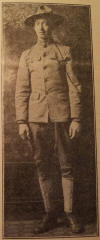 Among the boys from Anamosa in the Rainbow Division was Francis
Flaherty, son of Frank T. Flaherty. He was one of the first nine to
volunteer for service in the Machine Gun Company of the First Iowa,
enlisting on April 9, 1917, and going to camp one week later. He
went overseas with the Rainbow boys landing in England in December
1917, and soon went to the fighting front in France. He was wounded
in action in the great American offensive which began in July, 1918.
Particulars of the injury gathered from letters from himself and
companions show that during a heavy bombardment with high explosives
and gas shells he and a companion were buried by an upheaval of
earth. His gas mask was torn off and he was seriously affected by
the poison but extricated himself sufficiently to replace the mask
and then dig his companion out. Private Flaherty was confined in a
hospital in France for some weeks but has apparently fully
recovered. He came home with the Rainbow boys in May to Camp Dodge
and soon after returned home, modestly pursuing his former work as a
civilian.
Among the boys from Anamosa in the Rainbow Division was Francis
Flaherty, son of Frank T. Flaherty. He was one of the first nine to
volunteer for service in the Machine Gun Company of the First Iowa,
enlisting on April 9, 1917, and going to camp one week later. He
went overseas with the Rainbow boys landing in England in December
1917, and soon went to the fighting front in France. He was wounded
in action in the great American offensive which began in July, 1918.
Particulars of the injury gathered from letters from himself and
companions show that during a heavy bombardment with high explosives
and gas shells he and a companion were buried by an upheaval of
earth. His gas mask was torn off and he was seriously affected by
the poison but extricated himself sufficiently to replace the mask
and then dig his companion out. Private Flaherty was confined in a
hospital in France for some weeks but has apparently fully
recovered. He came home with the Rainbow boys in May to Camp Dodge
and soon after returned home, modestly pursuing his former work as a
civilian.
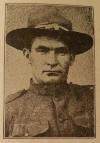 Clarence
Moore was one of the National Army from Jones County who met death
in battle on the western front of the great World War. He was born
near Canton, Jones County, Iowa, and registered at Olin when the
call was issued for the first registration. He was sent to Camp
Dodge for training in September, 1917, and later went overseas and
was killed in battle on October 6, 1918. He has relatives living
near Canton and also at Olin. Private Moore was married but we have
not a complete biographical sketch of his family. He was well and
favorably known in the community where he was raised and his
services in the war leaves rich heritage of memory to them and an
example of willing sacrifice which is useful to all Americans.
Clarence
Moore was one of the National Army from Jones County who met death
in battle on the western front of the great World War. He was born
near Canton, Jones County, Iowa, and registered at Olin when the
call was issued for the first registration. He was sent to Camp
Dodge for training in September, 1917, and later went overseas and
was killed in battle on October 6, 1918. He has relatives living
near Canton and also at Olin. Private Moore was married but we have
not a complete biographical sketch of his family. He was well and
favorably known in the community where he was raised and his
services in the war leaves rich heritage of memory to them and an
example of willing sacrifice which is useful to all Americans.
 Ray
S. Seely, son of Mr. and Mrs. W. B. Seely of Anamosa is among the
number who suffered wounds in battle in France. He enlisted early in
the war and became a member of Co. H. of the 59th Infantry which saw
much active service as a part of the Second division. He was in the
same Company in which Private Ed. Bakula was serving when the latter
was killed. Mr. Seely attained the rank of Sergeant by work in the
ranks. He was twice wounded and was invalided before the close of
the war, being unable to take part in the final campaign. He has
recovered from his wounds and is now happily married. Sergt. proved
to be a capable and courageous soldier and well sustains the
reputation of Iowa boys gained throughout the war.
Ray
S. Seely, son of Mr. and Mrs. W. B. Seely of Anamosa is among the
number who suffered wounds in battle in France. He enlisted early in
the war and became a member of Co. H. of the 59th Infantry which saw
much active service as a part of the Second division. He was in the
same Company in which Private Ed. Bakula was serving when the latter
was killed. Mr. Seely attained the rank of Sergeant by work in the
ranks. He was twice wounded and was invalided before the close of
the war, being unable to take part in the final campaign. He has
recovered from his wounds and is now happily married. Sergt. proved
to be a capable and courageous soldier and well sustains the
reputation of Iowa boys gained throughout the war.
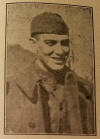 Howard
Countryman of Wyoming, Iowa, was an original member of Machine Gun
Co., 168th (Iowa) Regiment of the famous Rainbow Division. Little
need be said of these boys. Their fame is eternally written in the
pages of history and as they were recruited from the militia of
every state, their deeds are well known in every hamlet and village
of the United States. Private Countryman was of the original band of
about thirty men which left Jones County when war was declared in
April, 1917. The magnificent work done by this regiment under Col.
Bennett and Col. Tinley and the individual merit of the members have
been officially commended. They were of the same stuff as our other
soldiers but were the first to be favored with active service.
Private Countryman was injured by gas on May 27, 1918, and was
wounded in action in October, 1918, and was given a furlough. His
photograph since taken indicates he is happy and on the road to
recovery. Our office censor has eliminated the smiling companion in
the print here shown.
Howard
Countryman of Wyoming, Iowa, was an original member of Machine Gun
Co., 168th (Iowa) Regiment of the famous Rainbow Division. Little
need be said of these boys. Their fame is eternally written in the
pages of history and as they were recruited from the militia of
every state, their deeds are well known in every hamlet and village
of the United States. Private Countryman was of the original band of
about thirty men which left Jones County when war was declared in
April, 1917. The magnificent work done by this regiment under Col.
Bennett and Col. Tinley and the individual merit of the members have
been officially commended. They were of the same stuff as our other
soldiers but were the first to be favored with active service.
Private Countryman was injured by gas on May 27, 1918, and was
wounded in action in October, 1918, and was given a furlough. His
photograph since taken indicates he is happy and on the road to
recovery. Our office censor has eliminated the smiling companion in
the print here shown.
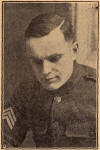 Walter
Leigh Pearson, son of Mr. and Mrs. W. K. Pearson of Anamosa enlisted
in the Engineer Corps in May, 1917, and became a member of Company
E., Second Engineers of the Second Division. This division saw some
of the fiercest fighting on the western front and at one time the
engineers were suddenly called into action by a German attack and
did heroic service in filling a breach in the ranks. Leigh spent
twenty months in the war area. He was wounded at Chateau Thierry in
June, 1918, and was confined to a hospital for some time. He
returned to this country with the last of the demobilized troops in
June, 1918. His injuries were caused partly by poison gas and the
hope is entertained by his friends that he will fully recover his
former health and vigor. He is the only child of devoted parents and
is highly respected in Anamosa where almost his entire life was
spent up to the time of going to war.
Walter
Leigh Pearson, son of Mr. and Mrs. W. K. Pearson of Anamosa enlisted
in the Engineer Corps in May, 1917, and became a member of Company
E., Second Engineers of the Second Division. This division saw some
of the fiercest fighting on the western front and at one time the
engineers were suddenly called into action by a German attack and
did heroic service in filling a breach in the ranks. Leigh spent
twenty months in the war area. He was wounded at Chateau Thierry in
June, 1918, and was confined to a hospital for some time. He
returned to this country with the last of the demobilized troops in
June, 1918. His injuries were caused partly by poison gas and the
hope is entertained by his friends that he will fully recover his
former health and vigor. He is the only child of devoted parents and
is highly respected in Anamosa where almost his entire life was
spent up to the time of going to war.
 Corporal
George Siebels of Amber though not the first to fight, saw active
service on the firing line. He went to Camp Dodge early in 1918 and
was quickly prepared to sail overseas. He received a wound in the
arm in action in France and was for sometime confined to a Hospital
in France. On returning to this country he was sent to the Hospital
at Des Moines for further treatment and then finally discharged.
Corp Siebels is a man of splendid physical stature and aside from
the wound on the arm he returned in good physical condition. He has
for several years been engaged in the mercantile business at Amber
with his brother Hank T. Siebels, also a soldier of the overseas
forces in the Selective Army.
Corporal
George Siebels of Amber though not the first to fight, saw active
service on the firing line. He went to Camp Dodge early in 1918 and
was quickly prepared to sail overseas. He received a wound in the
arm in action in France and was for sometime confined to a Hospital
in France. On returning to this country he was sent to the Hospital
at Des Moines for further treatment and then finally discharged.
Corp Siebels is a man of splendid physical stature and aside from
the wound on the arm he returned in good physical condition. He has
for several years been engaged in the mercantile business at Amber
with his brother Hank T. Siebels, also a soldier of the overseas
forces in the Selective Army.
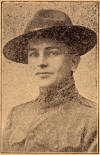 Harry
Kidwell was born February 12, 1893, in Fairview Township, Jones
County, son of Mr. and Mrs. Charles Kidwell. He enlisted after the
outbreak of the war and was sent overseas where he was soon in
active service on the fighting front. He was wounded in action
September 2, 1918, but the wounds proved not to be serious and Pri.
Kidwell completely recovered. In a letter written last Christmas
from Verdun he stated that his wounds were an injury to the leg and
a slight touch of poison gas. He was then about to go with the army
to Germany. Private Kidwell says that a companion by his side
standing next to him was killed and he was struck by a piece of the
shrapnel. He was in some of the most severe fighting.
Harry
Kidwell was born February 12, 1893, in Fairview Township, Jones
County, son of Mr. and Mrs. Charles Kidwell. He enlisted after the
outbreak of the war and was sent overseas where he was soon in
active service on the fighting front. He was wounded in action
September 2, 1918, but the wounds proved not to be serious and Pri.
Kidwell completely recovered. In a letter written last Christmas
from Verdun he stated that his wounds were an injury to the leg and
a slight touch of poison gas. He was then about to go with the army
to Germany. Private Kidwell says that a companion by his side
standing next to him was killed and he was struck by a piece of the
shrapnel. He was in some of the most severe fighting.
 Sergt.
Christophe Thalman of the French Army, though not an American has
lived many years here and his ardent admiration for the American
solider has frequently been expressed by him in public addresses.
Sergt. Thalman was residing in America when the war broke out in
Europe and returned to his native country, France, to take his part
in the service of his country. He was an officer of the famous
French Chasseurs, the "Blue Devils" who did such heroic work in
stemming the tide of militarism rushing down from the habitat of the
fierce and cruel Allenmania. His work and those of his fellow
sustained the reputation of that heroic race who have for centuries
beaten back hordes from all sides. He is a lone survivor of the
original Ninth Chasseurs. He was incapacitated by many injuries and
was given a furlough after three years service and has since made
his home in Anamosa where he has engaged in patriotic work by public
appeals.
Sergt.
Christophe Thalman of the French Army, though not an American has
lived many years here and his ardent admiration for the American
solider has frequently been expressed by him in public addresses.
Sergt. Thalman was residing in America when the war broke out in
Europe and returned to his native country, France, to take his part
in the service of his country. He was an officer of the famous
French Chasseurs, the "Blue Devils" who did such heroic work in
stemming the tide of militarism rushing down from the habitat of the
fierce and cruel Allenmania. His work and those of his fellow
sustained the reputation of that heroic race who have for centuries
beaten back hordes from all sides. He is a lone survivor of the
original Ninth Chasseurs. He was incapacitated by many injuries and
was given a furlough after three years service and has since made
his home in Anamosa where he has engaged in patriotic work by public
appeals.